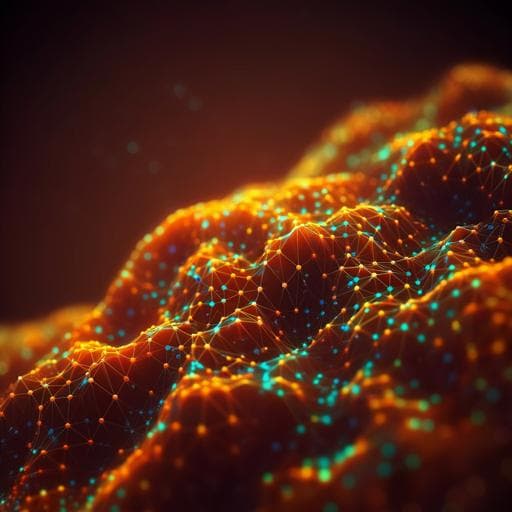
Medicine and Health
BMPER is a marker of adipose progenitors and adipocytes and a positive modulator of adipogenesis
J. D. Garritson, J. Zhang, et al.
This groundbreaking research by Jacob D. Garritson and colleagues delves into the mysteries of autocrine and paracrine signaling in white adipose tissue. Utilizing cutting-edge single-cell RNA-sequencing, they unveil essential markers of adipose progenitor cells and identify BMPER as a key player in the adipogenesis process. Discover how this study highlights sex and diet-specific differences in cellular clusters and its implications for understanding fat tissue biology.
~3 min • Beginner • English
Introduction
Obesity, particularly visceral adiposity, is strongly associated with adverse metabolic and cardiovascular outcomes. White adipose tissue expands via hypertrophy of existing adipocytes or hyperplasia through de novo recruitment and differentiation of adipose progenitor cells (APCs). Prior work indicates visceral APCs are heterogeneous and functionally distinct, but definitive markers and modulators governing adipogenesis in visceral adipose tissue (VAT) remain incompletely defined. This study aimed to use single-cell and single-nucleus transcriptomics in human omental and mouse perigonadal VAT to: (1) catalog major stromal vascular cell types and assess sex- and obesity-dependent differences, (2) identify conserved APC markers, and (3) discover factors that modulate adipogenesis. The authors hypothesized that conserved transcripts would identify visceral APCs and that such candidates could regulate adipogenic differentiation.
Literature Review
Previous studies have highlighted VAT APC heterogeneity and intrinsic adipogenic potential in vitro and in vivo, supported by sc/snRNA-seq atlases in humans and mice. Mesothelial cells have been proposed as contributors to VAT adipocytes in mice, though this remains debated. Obesity is consistently associated with increased immune cell infiltration in VAT. Sex-specific differences in adipose tissue biology and macrophage populations have been reported, with male mice showing greater susceptibility to inflammatory remodeling under high-fat diet. BMP4 signaling promotes adipogenic commitment of human adipose stem cells, and BMPER (Crossveinless-2), a secreted BMP modulator originally identified in Drosophila and endothelial contexts, has been implicated in metabolic phenotypes (e.g., insulin resistance upon endothelial Bmper loss) and upregulated in pericardial adipose stem cells with obesity. However, BMPER’s role in adipogenesis had not been elucidated.
Methodology
Human samples: Omental (visceral) adipose tissue was collected under IRB-approved protocols from 9 surgical patients (2 lean males, 2 obese males, 2 lean females, 3 obese females). Patients fasted ≥7 h; bariatric patients followed a high-protein very low-calorie diet for 4 weeks pre-surgery. Exclusion criteria included active malignancy, infection, or inflammatory surgical conditions. Public snRNA-seq datasets (GSE176171) from omental fat of 7 patients were reanalyzed.
Mice and diets: Eight-week-old male and female C57BL/6J mice were fed 8 weeks of either normal chow diet (10% kcal fat) or high-fat diet (60% kcal fat). Perigonadal WAT was collected. For scRNA-seq, per group samples pooled fat from 10 mice (1 NCD male, 1 HFD male, 1 NCD female, 1 HFD female). Public snRNA-seq perigonadal fat (GSE176171) from 12 mice (2 NCD females, 2 HFD females, 3 NCD males, 5 HFD males) was reanalyzed. GTT/ITT and body composition were performed by standard protocols.
SVF isolation and scRNA-seq: Human and mouse VAT were enzymatically digested. SVF were RBC-lysed, washed, and prepared in PBS + 0.04% BSA. Libraries were generated with 10x Genomics and sequenced on Illumina NovaSeq 6000 (150×150 paired-end). Cell Ranger v3.1.0 aligned reads to GRCh38 or GRCm38. In Seurat v4.0.1, cells with >15% (human) or >10% (mouse) mitochondrial reads, <300 features, or >6000 features were removed; data were normalized with SCTransform. Clustering used 15 PCs, resolution 0.5; UMAP visualizations were generated. Cell types were annotated using canonical markers (PDGFRA, PTPRC, MSLN, PECAM1) and SingleR. DEGs were identified with Wilcoxon tests; pseudobulking was used for FAP contrasts. Enrichment analyses used clusterProfiler and WikiPathways.
Cross-species FAP integration: PDGFRA+ fibro-adipogenic progenitors (FAPs) were re-clustered. Mouse-to-human homologs from MGI yielded 14,211 common genes. SCTransform integration (PreSCTIntegration) identified anchors; PCA/UMAP used 10 dimensions, resolution 0.4, defining seven conserved FAP clusters, further categorized into uncommitted progenitors (FAP1; PI16+, SEMA3C+, OSR2+), committed APCs (FAP4; ICAM1+, CEBPB+), fibro-progenitors (FAP6; VCAN+, MFAP5+, HTRA3+), and additional clusters with immune-like signatures.
APC isolation and differentiation: Mouse visceral APCs were purified by FACS as Lin−, CD34+, CD29+, Sca1+, CD200− from eWAT (males) or peri-ovarian WAT (females) from NCD or HFD mice. Cells were cultured in DMEM/F-12 growth media to >75% confluence, then differentiated with insulin, dexamethasone, and IBMX for 3 days before switching to growth media for 3 additional days. Lipid accumulation was quantified by BODIPY staining; mRNA expression (Pparg, Fabp4, Pdgfra, Bmper) was measured by qPCR (normalized to Rpl13; ΔCT method).
3T3-L1 assays: 3T3-L1 preadipocytes were cultured to confluence and differentiated with insulin/Dex/IBMX, followed by insulin-containing maintenance media. Oil Red O staining quantified lipid content; kinetic lipid accumulation was tracked with BODIPY 493/503 and IncuCyte imaging. siRNA knockdown used 25 nM siRNA and DharmaFECT; differentiation initiated 96 h post-transfection. Secreted BMPER was measured by ELISA.
Immunocytochemistry: Cells were fixed and stained for BMPER and Golgin-97 with appropriate primary and fluorescent secondary antibodies; DAPI counterstain was used.
Conditional Bmper allele and APC knockout: Bmperfl/fl mice were generated via CRISPR/Cas9 insertion of LoxP sites flanking exon 4 using ssDNA donor and RNPs targeting introns 3 and 4. Genotyping confirmed insertion. Male Bmperfl/fl visceral APCs were infected with Ad-CMV-GFP or Ad-CMV-Cre-GFP (6×10^8 PFU/well, 48 h) prior to differentiation. GFP confirmed infection. Bmper knockdown was assessed by qPCR; adipogenesis by BODIPY; Pparg and Fabp4 mRNA were quantified. Controls confirmed adenoviral Cre did not alter differentiation in WT APCs.
Statistics: Data are mean ± SD. Two-tailed unpaired t-tests, two-way ANOVA with Tukey post hoc where appropriate; p < 0.05 considered significant. Sample sizes: human scRNA-seq n=9; human snRNA-seq reanalysis n=7; mouse scRNA-seq pooled samples (4 total); mouse snRNA-seq reanalysis n=12.
Key Findings
- scRNA-seq identified four major VAT SVF clusters (FAPs, immune, mesothelial, endothelial) in human omental and mouse perigonadal fat, robustly separated by transcriptional profiles.
- Obesity effects: In human snRNA-seq reanalysis, obesity significantly reduced adipose progenitors (ASPCs) and increased macrophage proportions independent of sex; similar immune cell increases were observed in obese mice.
- Sex differences: In human scRNA-seq, females had a higher proportion of immune cells and fewer FAPs than males (p=0.0014). In mice, females showed proportionally more FAPs and fewer immune cells than males.
- Sex-dependent transcription: Mice exhibited more pronounced sex-biased DEGs than humans across FAP, immune, and mesothelial clusters. Male mouse FAPs showed a pro-adipogenic/lipogenic signature (elevated Sult1e1, Col6a5, Ace); male immune clusters had higher macrophage-associated transcripts (e.g., Gpnmb, Trem2).
- FAP heterogeneity: Cross-species integration resolved seven conserved FAP clusters, including uncommitted progenitors (FAP1), committed APCs (FAP4), and fibro-progenitors (FAP6). Obesity tended to increase committed and fibro-progenitor fractions in humans; HFD mice had relatively more uncommitted APCs versus committed/fibro-progenitors.
- Adipogenic capacity varies by sex and diet: Purified visceral APCs (Lin−, CD34+, CD29+, Sca1+, CD200−) from NCD-fed male mice were highly adipogenic in vitro; female APCs were refractory. HFD significantly reduced adipogenesis in male APCs and resulted in virtually no differentiation in female APCs. Pparg and Fabp4 mRNA increased upon differentiation in male NCD APCs; Pparg was reduced in differentiated APCs from obese versus lean males; undifferentiated female APCs had higher Pdgfra than males yet were refractory to differentiation.
- BMPER as conserved APC/adipocyte marker: BMPER/Bmper expression marked PDGFRA+ FAPs in both human and mouse VAT and was detectable in mature adipocytes in snRNA-seq. In mouse VAT fractions, Lin− SVF had the highest Bmper mRNA compared to adipocytes and Lin+ SVF. Bmper mRNA was approximately two-fold higher in male versus female visceral APCs (p<0.005).
- Bmper dynamics in adipogenesis: In 3T3-L1 preadipocytes, Bmper mRNA rose during differentiation, correlating with Pparg induction, and secreted BMPER protein in media peaked at day 4 post-differentiation.
- Functional requirement for BMPER: siRNA knockdown of Bmper in 3T3-L1 cells reduced lipid accumulation (Oil Red O and BODIPY) and attenuated adipogenesis. In primary male mouse visceral APCs from Bmperfl/fl mice, adenoviral Cre-mediated Bmper deletion (~90% reduction) significantly reduced lipid accumulation (BODIPY/DAPI) and decreased Pparg and Fabp4 mRNA after differentiation.
- In human datasets, the proportion of BMPER+ cells in APC clusters negatively correlated with BMI, while BMPER+ adipocyte nuclei positively correlated with BMI, consistent with a pro-adipogenic role for BMPER in VAT.
Discussion
This study addressed the need for robust markers and modulators of visceral adipogenesis by leveraging scRNA-seq and snRNA-seq across species and sexes. The authors show that VAT cellular composition differs by sex and obesity status, with consistent obesity-associated immune infiltration in humans and mice. Mice exhibit stronger sex-dependent transcriptional divergence than humans, notably a pro-adipogenic gene program in male FAPs and increased macrophage-associated transcripts in males. Re-clustering and cross-species integration identified conserved FAP states (uncommitted, committed, and fibro-progenitors), offering a framework for comparative analyses.
Crucially, BMPER emerged as a conserved marker of PDGFRA+ APCs and adipocytes and a functional positive modulator of adipogenesis. Enrichment of Bmper in Lin− SVF, higher expression in male APCs, induction during preadipocyte differentiation, and reduced lipid accumulation and adipogenic gene expression upon Bmper depletion together support that BMPER acts upstream of Pparg/Fabp4 and facilitates adipogenic commitment and differentiation. Given BMP4’s known pro-adipogenic effects and BMPER’s context-dependent modulation of BMP signaling, BMPER likely influences early commitment and possibly clonal expansion or migration during adipogenesis. The observed positive correlation of BMPER+ adipocytes with BMI and negative correlation of BMPER+ APCs with BMI in human VAT suggest dynamic regulation of BMPER across differentiation states in obesity.
Overall, the findings provide mechanistic insight into sex- and diet-dependent variability in visceral APC adipogenic potential and establish BMPER as both a marker and positive regulator relevant to VAT remodeling and metabolic health.
Conclusion
- The study delivers a cross-species single-cell atlas of human omental and mouse perigonadal VAT, revealing sex- and obesity-dependent differences in cellular composition and transcriptional states.
- Conserved FAP subpopulations were defined, including uncommitted progenitors, committed progenitors, and fibro-progenitors.
- BMPER was identified as a conserved marker of visceral APCs and adipocytes and shown to be required for efficient adipogenesis in 3T3-L1 cells and primary mouse visceral APCs.
- Sex and diet modulate visceral APC adipogenic potential, with male APCs being more adipogenic than female APCs and obesity diminishing male APC adipogenesis.
Future directions include mechanistic dissection of BMPER’s modulation of BMP signaling in APC commitment and differentiation, in vivo lineage and functional studies of BMPER in VAT remodeling, exploration of depot- and sex-specific regulation, and evaluation of BMPER as a potential therapeutic target to modulate adipose tissue expansion and metabolic outcomes.
Limitations
- Human sample size was small (n=9), limiting statistical power and generalizability; interpatient variability may mask effects. Female subjects were menopausal, potentially influencing VAT cellular composition.
- Depot differences (human omental versus mouse gonadal VAT) and sex hormone milieus may confound cross-species comparisons of cell proportions and transcriptional signatures.
- BMPER was identified as an APC marker by scRNA-seq but is also expressed in adipocytes in snRNA-seq, indicating stage-dependent expression that complicates strict APC-specificity.
- Mouse scRNA-seq used pooled samples (10 mice per condition), limiting assessment of biological variability within groups.
- Mechanistic pathways by which BMPER modulates adipogenesis (e.g., specific BMP ligands/receptors, downstream signaling nodes) were not fully delineated.
Related Publications
Explore these studies to deepen your understanding of the subject.







